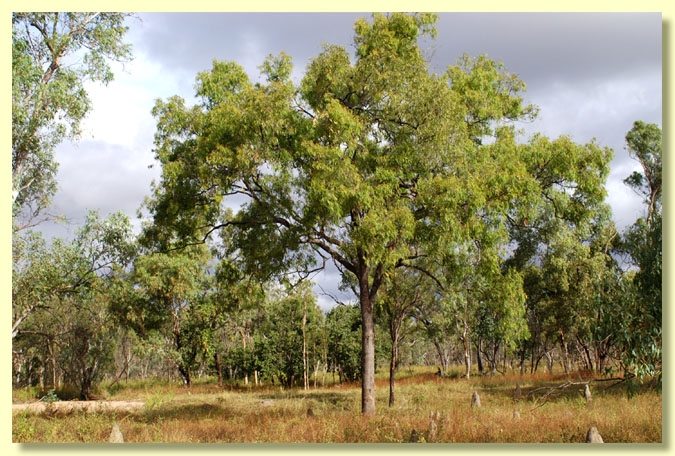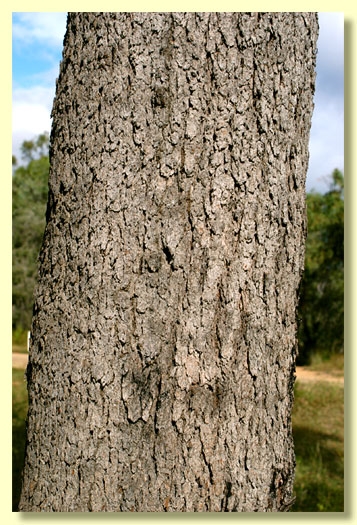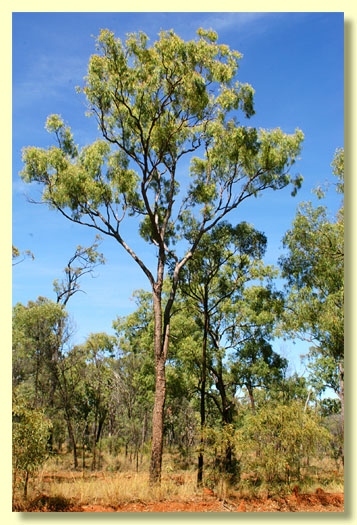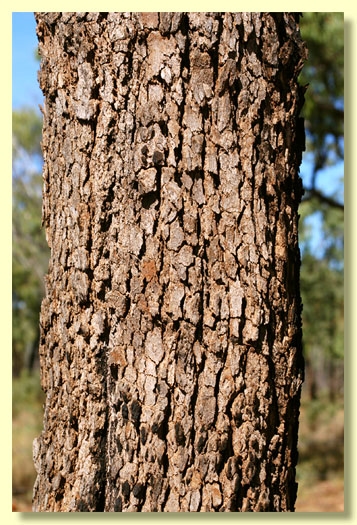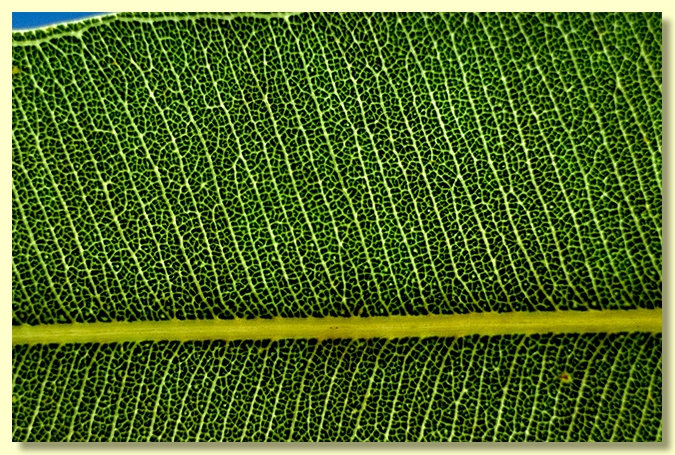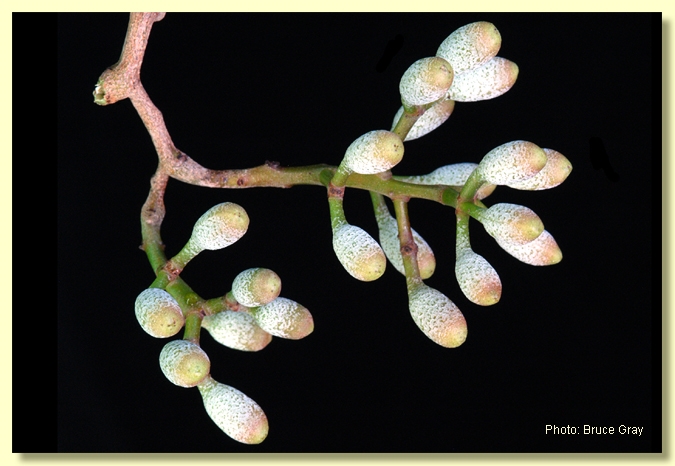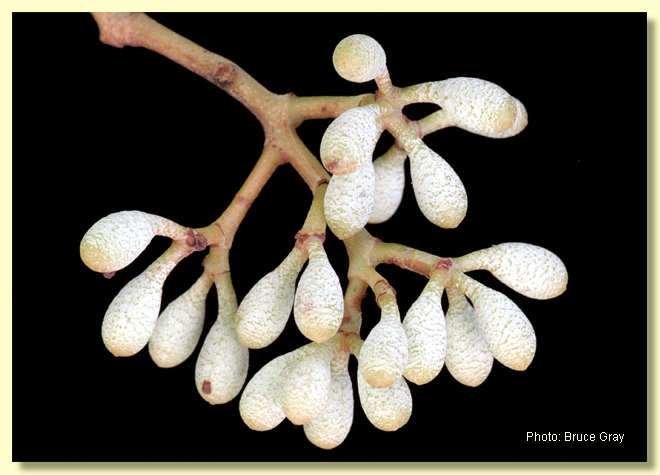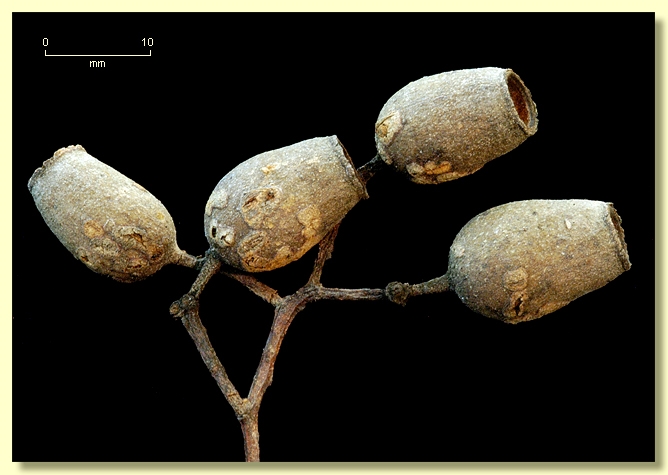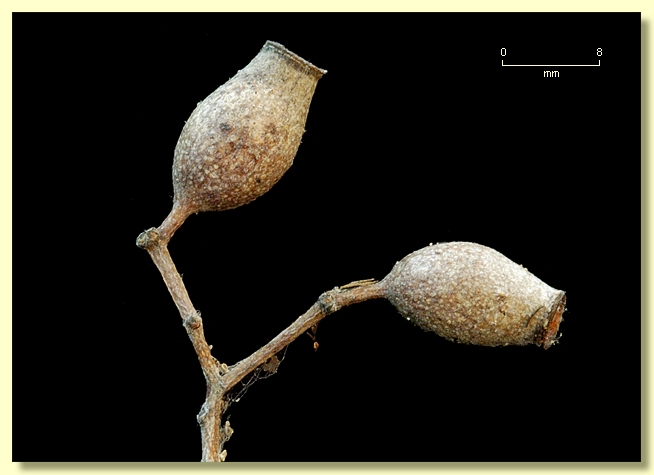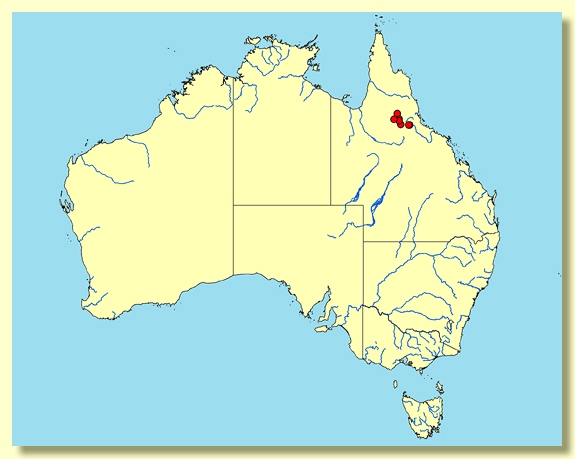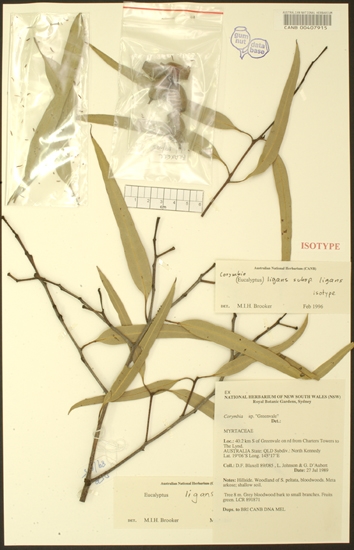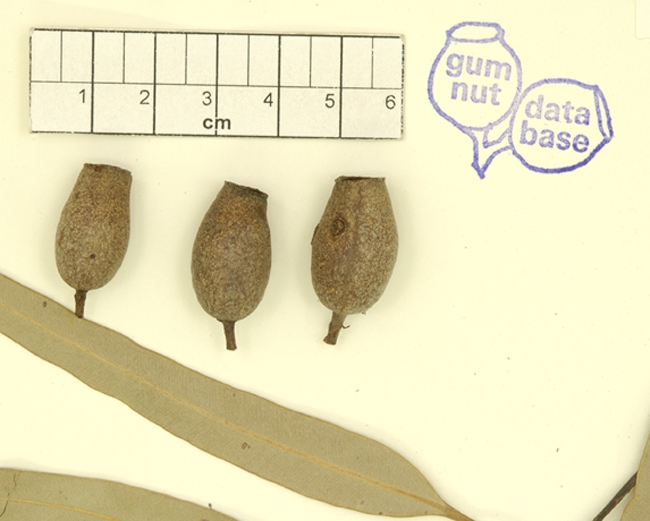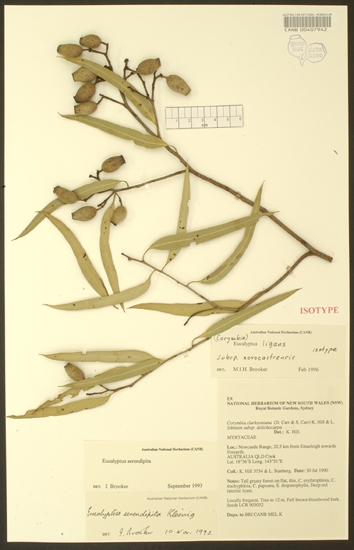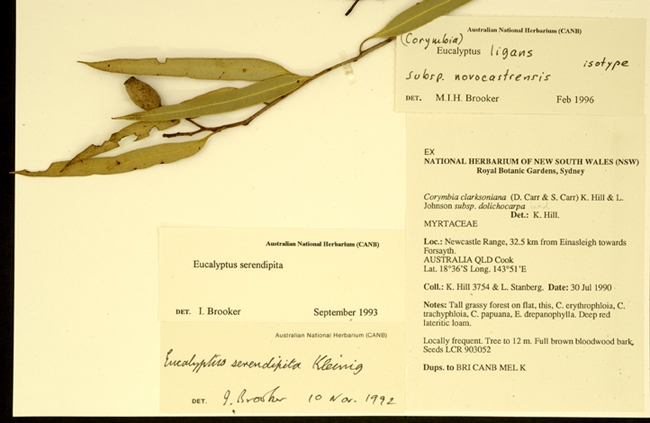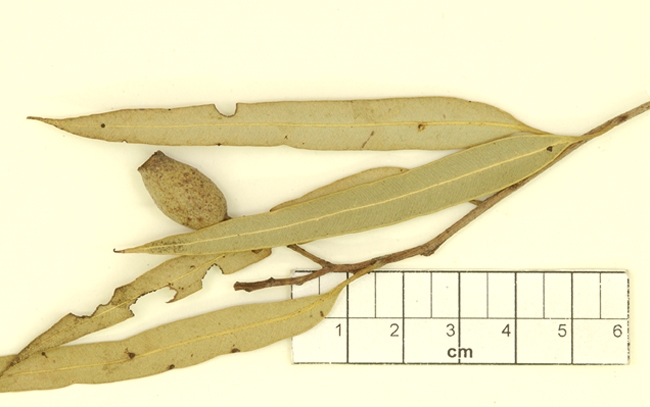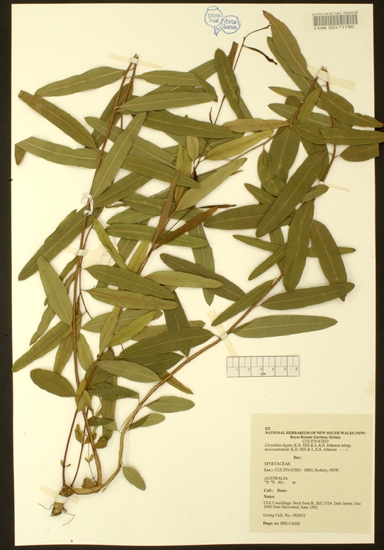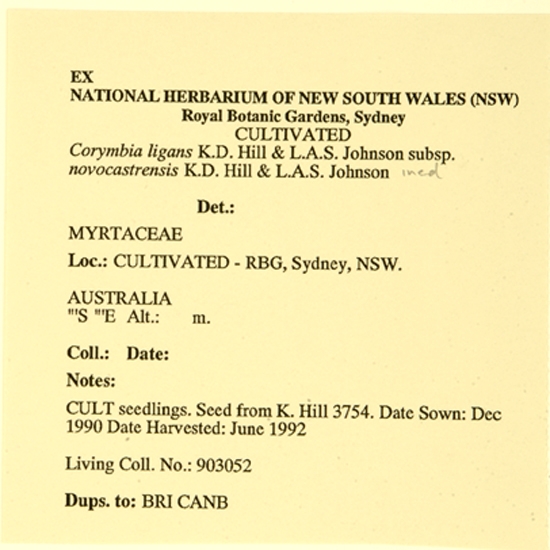Corymbia | Rufaria
Euclid - Online edition
Corymbia ligans
Corymbia ligans K.D.Hill & L.A.S.Johnson, Telopea 6: 263 (1995).
Tree to 20 m tall. Forming a lignotuber.
Bark rough to the smallest branches, tessellated or shortly fibrous, grey and grey-brown.
Branchlets smooth (glabrous); lack oil duct in the pith.
Juvenile growth (coppice or field seedlings to 50 cm): stems rounded, smooth, if setae present then only on lowest internodes; juvenile leaves shortly petiolate (petioles < 1 cm long), opposite only at lower nodes, predominantly alternate, narrowly elliptic at lower nodes becoming lanceolate up the stem, (5.5)8–14 cm long, 1.3–1.8 cm wide, base tapering to petiole, apex bluntly pointed, green, discolorous, becoming glossy on upper growth, smooth except for sparse setae on veins on underside of lowest leaves.
Adult leaves alternate, petioles 0.8–1.9 cm long; blade narrowly lanceolate, 7.7–15(17.5) cm long, 0.8–1.6(2) cm wide, base tapering to petiole, margin entire, apex pointed, discolorous, glossy, green, side-veins at greater than 45° to midrib, reticulation very dense, intramarginal vein present and close to margin, visible at least on the underside, oil glands island, one per areole, or obscure.
Inflorescence terminal compound, peduncles 0.5–1.8 cm long, buds 7 per umbel, pedicels 0.3–0.6 cm long. Mature buds obovoid to narrowly pyriform, 0.7–0.9 cm long, 0.4–0.5 cm wide, scurfy (whitish scaly surface due to fragmenting cuticle), scar absent (both opercula shed together at flowering), operculum shallowly rounded, stamens inflexed, all fertile, anthers oblong, dorsifixed, versatile, dehiscing by longitudinal slits, style long and straight, stigma blunt and long-papillose, locules 4, the placentae each with ovule not arranged in distinct rows. Flowers not seen.
Fruit pedicellate (pedicels 0.2–0.6 cm long), elongated barrel-shaped tapering distally, sometimes slightly consticted below the rim, 1.1–2 cm long, 0.7–1.2 cm wide, always longer than wide (1.4–1.9 times as long as wide), surface ± smooth, disc descending vertically, valves 4, enclosed.
Seeds brown, 6–8 mm long, ellipsoidal with terminal wing, hilum subterminal.
Cultivated seedlings (measured at ca node 10): cotyledons large, reniform; stems rounded in cross-section, setose with short bristle-glands for up to ca 4 nodes then smooth; leaves always petiolate, opposite for ca 8 nodes then sub-opposite, narrowly elliptical or narrowly lanceolate, 7.5–9 cm long, 1.2–1.8 cm wide, base tapering to petiole, dull or slightly glossy, green, only sparsely setose on lower 4 pairs of leaves, then smooth.
Mature buds have been collected in January but actual flowering time has not been recorded.
A bloodwood tree endemic to north-eastern Queensland and restricted to hills in the Greenvale area extending west to The Lynd, Einasleigh and the Newcastle Range, and with an outlier further to the south-east in the country west of Balfes Creek. It has been recorded as a component of savannah woodlands in a range of habitats from hillsides and elevated flat areas with shallow soil, to well-drained flats with deeper sandy soil near creeks. Corymbia ligans has rough tessellated bark extending to the smallest branches, a crown of adult leaves, glossy green above and always paler on the underside, small scurfy buds in terminal panicles and small ± barrel-shaped fruit that taper slightly to the rim which is not flared. Juvenile growth is poorly known but from pot-grown seedlings the stems and leaves are only setose on the earliest internodes and lowest leaves, and the leaves are opposite to sub-opposite and narrowly elliptic to lanceolate.
In the field C. ligans looks very much like a depauperate form of the widespread tropical species C. polycarpa, having similarly scurfy buds and fruit of a similar shape, but differs in having smaller fruit with smaller seeds and predominantly narrower adult leaves (though with some overlap in dimensions in each case). The widespread bloodwood C. clarksoniana (here including C. dolichocarpa and C. maritima) is also closely related to C. ligans and overlaps in distribution, but differs in having larger buds, larger and more obese urceolate fruit, and wider adult leaves (but again with some overlap in dimensions). All the species mentioned in this paragraph, along with the northern C. novoguinensis, were once included in a wide-ranging and very variable Eucalyptus polycarpa. Collections of C. ligans are few and time will tell if it is worthy of specific distinction. See table below for fruit comparison of these four related species.
Hill & Johnson (1995) divided C. ligans into three subspecies based on fruit shape, fruit length: width ratios, and on stomatal distribution on the leaf surfaces. In EUCLID we regard C. ligans subsp. novocastrensis as the same as typical C. ligans, as it differs little in bud, fruit and leaf features. Stomata in subsp. novocastrensis are distributed on both leaf surfaces (only on the lower surface in subsp. ligans) according to Hill & Johnson (1995). The third subspecies, C. ligans subsp. burdekinensis, we regard as synonymous with C. clarksoniana, with which it completely overlaps in fruit shape and dimensions and almost completely overlaps in adult leaf dimensions, although the juvenile leaves are a bit smaller in the former (but again with some overlap).
Using a combination of bark, bud, fruit and adult leaf features, and geography, the botanist should be able to identify C. ligans as distinct from other bloodwoods in the area.
This table shows that fruit shape rather than dimensions is the best guide to these four related species:
Species
Fruit shape
Fruit length cm
Fruit width cm
Length: width ratio
clarksoniana
urn-shaped
1.2–2.5
0.9–1.6
1.1 to 1.8
ligans
1.1–2
0.7–1.2
1.4 to 1.9
novoguinensis
urn-shaped to barrel-shaped, contracted slightly in upper part with the rim slightly flared
1.7–2.4(3)
1.1–1.5(2)
1.3 to 1.7
polycarpa
elongated barrel-shaped
1.5–3.5
0.8–1.6
1.6 to 2.1
MORE ABOUT CORYMBIA
MORE ABOUT RED BLOODWOODS
Corymbia ligans: Latin ligo, to tie or bind, an obscure and unexplained reference by the authors of this species, perhaps referring to its placement between C. polycarpa and C. clarksoniana.

